Lupus constellation lies in the southern hemisphere, between Centaurus and Scorpius. Its name means “the wolf” in Latin.
Lupus was first catalogued by the Greek astronomer Ptolemy in the 2nd century. Even though it is an old constellation, Lupus is not associated with any myths.
The constellation is home to several interesting stars and deep sky objects. These include the historic supernova remnant SN 1006, the globular clusters NGC 5824 and NGC 5986, and the Retina Nebula (IC 4406).
Facts, location and map
Lupus is the 46th constellation in size, occupying an area of 334 square degrees. It is located in the third quadrant of the southern hemisphere (SQ3) and can be seen at latitudes between +35° and -90°. The neighboring constellations are Centaurus, Circinus, Hydra, Libra, Norma and Scorpius.
The constellation name Lupus is pronounced /ˈljuːpəs/. In English, the constellation is known as the Wolf. The genitive form of Lupus, used in star names, is Lupi (pronunciation: /ˈljuːpaɪ/). The three-letter abbreviation, adopted by the International Astronomical Union (IAU) in 1922, is Lup.
Lupus belongs to the Hercules family of constellations, along with Aquila, Ara, Centaurus, Corona Australis, Corvus, Crater, Crux, Cygnus, Hercules, Hydra, Lyra, Ophiuchus, Sagitta, Scutum, Sextans, Serpens, Triangulum Australe and Vulpecula.
Lupus contains two stars with known planets and no Messier objects. The brightest star in the constellation is Men, Alpha Lupi, with an apparent magnitude of 2.30. There are no meteor showers associated with the constellation.
Lupus does not contain any formally named stars.
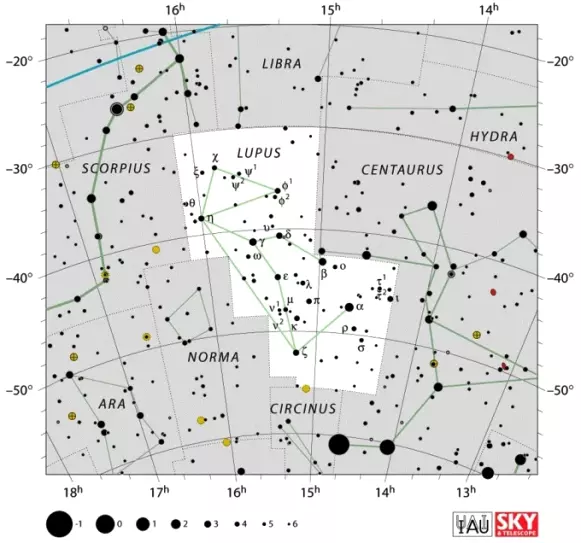
Lupus constellation map by IAU and Sky&Telescope magazine
Story
The stars that now form the constellation Lupus used to be part of Centaurus constellation. They represented a sacrificed animal impaled by the centaur. The centaur was holding it toward the constellation Ara, the altar.
The constellation was not associated with any animal in particular until the Renaissance times, when the Latin translation of Ptolemy’s work identified it with the wolf.
The Greeks knew the constellation as Therium, a wild animal, and the Romans called it Bestia, the beast. In Greek times, the constellation was probably taken to represent a creature based on the Babylonian figure of the Mad Dog. The creature was a hybrid, with a human head and torso and legs and tail of a lion. The creature was frequently associated with the sun god and Bison-man, which is another creature from myth, and it was called UR.IDIM, with UR referring to a large carnivore, which could have been a lion, wolf, or a dog.
Lupus stars
α Lupi (Alpha Lupi)
Alpha Lupi is the brightest star in Lupus constellation. It has an apparent magnitude of 2.30 and is approximately 460 light years distant from Earth. It is a blue-white giant star with the stellar classification B1.5III. It is ten times more massive than the Sun and about 25,000 times more luminous.
Alpha Lupi is classified as a Beta Cephei variable. It exhibits periodic variations in luminosity, by about 0.03, as a result of pulsations in the atmosphere. It has a period of 0.29585 days, which translates into about 7 hours and 6 minutes.
β Lupi (Beta Lupi)
Beta Lupi is the second brightest star in the constellation. It has an apparent magnitude of 2.68 and is approximately 383 light years distant from Earth. Like Alpha Lupi, it is classified as a Beta Cephei variable. It is a multi-period variable, with a dominant period of 0.232 days.
Beta Lupi is a blue-white giant of the spectral type B2 III. It is believed to be about 25 million years old. The star has about 8.8 solar masses and a relatively high proper motion. It is located near the supernova remnant SN 1006.
γ Lupi (Gamma Lupi)
Gamma Lupi is a blue-white subgiant star in Lupus. It is the third brightest star in Lupus. It belongs to the stellar class B2 IV. It has an apparent magnitude of 2.77 and is approximately 420 light years distant from the solar system. It is in fact a close binary system in which the primary component is itself a spectroscopic binary star, one that has an orbital period of 2.8081 days.
δ Lupi (Delta Lupi)
Delta Lupi is another blue-white subgiant with the stellar classification B1.5 IV. It has an apparent magnitude of 3.22 and is approximately 900 light years distant from the Sun.
The star is about 10,000 times more luminous than the Sun and has 12 times the mass. It has a radius 6.1 times solar. The star is believed to be about 15 million years old.
Delta Lupi is classified as a Beta Cephei variable. It has a period of 0.1655 days, or six cycles per day.
ε Lupi (Epsilon Lupi)
Epsilon Lupi is another multiple star system in Lupus. It has a visual magnitude of 3.41 and is approximately 510 light years distant from the Sun.
Epsilon Lupi is a so-called double-lined spectroscopic binary. When the system’s spectrum is examined, both stars’ absorption line features can be observed. The lines shift back and forth as the stars orbit each other. The two stars have not yet been resolved through a telescope. They share a close orbit with a period of 4.55970 days.
The binary system has a companion separated by 26.5 seconds of arc that may be orbiting the binary star with a period of 64 years.
The Epsilon Lupi system has a combined stellar classification B2 IV-V, and the individual stars are thought to have spectral classes of B3 IV (blue-white subgiant), B3 V (blue-white dwarf), and A5 V (white dwarf).
ζ Lupi (Zeta Lupi)
Zeta Lupi is a yellow giant star belonging to the stellar class G7III. It has an apparent magnitude of 3.41 and is approximately 116 light years distant from the Sun.
η Lupi (Eta Lupi)
Eta Lupi is a blue-white subgiant with the stellar classification of B2.5 IV. It has an apparent magnitude of 3.41 and is approximately 493 light years distant from the solar system.
ι Lupi (Iota Lupi)
Iota Lupi is another class B subgiant. It has the stellar classification B2.5IV and is approximately 352 light years distant from Earth. The star has a visual magnitude of 3.54.
φ Lupi (Phi Lupi)
The designation Phi Lupi is shared by two separate stars. Phi-1 Lupi is an orange giant with the stellar classification K5 III. It has an apparent magnitude of 3.58 and is approximately 326 light years distant from Earth.
Phi-2 Lupi is a blue-white main sequence star belonging to the stellar class B4V. It has an apparent magnitude of 4.52 and is approximately 606 light years distant from the solar system.
π Lupi (Pi Lupi)
Pi Lupi is a star in a double system. It has an apparent magnitude of 3.98 and is approximately 497 light years distant from the Sun. It belongs to the spectral class B5.
KT Lupi (114 G. Lupi)
KT Lupi is a blue-white subgiant star with the stellar classification of B3IVp. It has an apparent magnitude of 4.54 and is approximately 434 light years distant from Earth. It is a Be star, a class B star with strong hydrogen emission lines and distinctive forbidden neutral or low ionization emission lines in its spectrum.
τ Lupi (Tau Lupi)
Tau Lupi is a designation shared by Tau-1 Lupi, a blue-white subgiant star belonging to the stellar class B2IV with an apparent magnitude of 4.55, and Tau-2 Lupi, an F7-class star with a visual magnitude of 4.36. Tau-1 Lupi is approximately 1,035 light years distant, and Tau-2 is located about 314 light years from Earth. Tau-1 Lupi is classified as a Beta Cephei variable star.
1 Lupi
1 Lupi is a yellow-white bright giant star with the stellar classification F1II. It has an apparent magnitude of 4.91 and is approximately 1,140 light years distant.
ν Lupi (Nu Lupi)
Nu Lupi is a designation shared by two stars, Nu-1 Lupi and Nu-2 Lupi. Nu-1 Lupi is a yellow-white star halfway between the subgiant and giant evolutionary stage. It has the stellar classification of F6III-IV. The star has an apparent magnitude of 5.00 and is approximately 111 light years distant from the solar system.
Nu-2 Lupi is a yellow main sequence star only 48.3 light years from Earth. It is very similar to the Sun, but has a significantly lower metallicity. Nu-2 Lupi has an abnormally high velocity. It has a mass 1.02 times solar and a radius 1.01 solar. It is 0.99 times as luminous as the Sun and has a rotational velocity of 2 km/s.
Three planets were discovered orbiting Nu-2 Lupi in September 2011. The innermost and outermost ones are super-Earths, with masses 5.28 and 9.59 times that of the Earth. Super-Earths are extrasolar planets that are more massive than Earth, but substantially less massive than the smaller gas giants in the solar system (Uranus and Neptune). The middle planet is too massive to be a super-Earth, with a mass 11.38 times that of our planet. All three planets orbit the star within 0.5 astronomical units, which means that they are likely too hot for life.
GQ Lupi
GQ Lupi is an orange main sequence star classified as a T Tauri variable. It has an apparent magnitude of 11.40 and is approximately 500 light years distant from Earth. The star has about 70 percent of the Sun’s mass and is less than 2 million years old.
A substellar object, GQ Lupi b, was discovered orbiting the star in 2005. It was one of the first extrasolar planet candidates to be directly imaged.
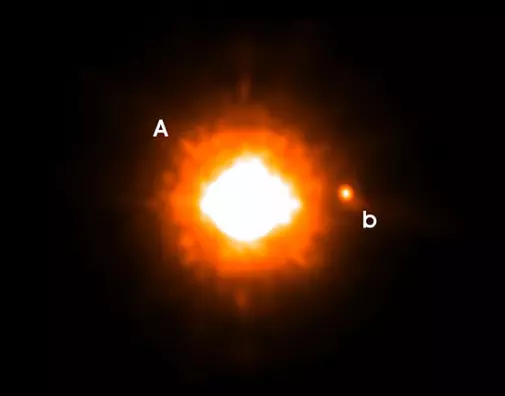
GQ Lupi – The feeble point of light to the right of the star is the newly found cold companion. It is 250 times fainter than the star itself and it located 0.73 arc seconds west. At the distance of GQ Lupi, this corresponds to a distance of roughly 100 astronomical units. North is up and East is to the left. Image: ESO
RU Lupi
RU Lupi is a yellow star with the stellar classification of G5V:e. It has an apparent magnitude of 10.519 and is approximately 400 light years distant from Earth. It is another T Tauri variable star in Lupus, a very young, low-mass star that has not quite reached the main sequence stage. It is believed to be between 2 and 3 million years old.
RU Lupi exhibits random variations in brightness, including fluctuations in ultraviolet and X-ray emissions. It has 60-70 percent of the Sun’s mass, 1.6 times the solar radius, and is more than twice as luminous as the Sun. The star is surrounded by a circumstellar disk of dust.
RU Lupi has an unconfirmed substellar companion in its orbit. If the companion exists, it has a mass at least 27 times that of Jupiter and orbits the star with a period of 3.71 days.
Lupus-TR-3
Lupus-TR-3 is a dim orange main sequence star in Lupus. It has an apparent magnitude of 17.4 and is approximately 8,950 light years distant from Earth. It has the stellar classification of K1V.
An exoplanet, Lupus-TR-3 b, was discovered in the star’s orbit in 2007. The planet has 0.81 times the mass of Jupiter and orbits the star with a period of 3.91405 days. It is the faintest transiting planet ever detected using ground-based methods (transit method).
Deep sky objects in Lupus
NGC 5986
NGC 5986 is a globular cluster in the constellation. It is 33,900 light years distant from Earth. The cluster is notable because it contains two very bright A-F class stars which are likely in their last stage of evolution off the asymptotic giant branch.
The cluster has an apparent magnitude of 7.52. It can be found 2.5 degrees to the west-northwest of the star Eta Lupi.
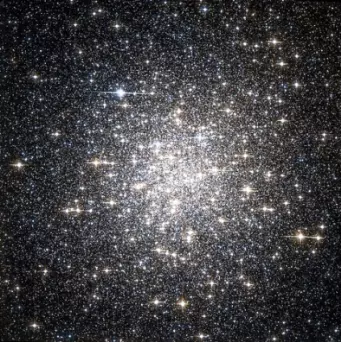
NGC 5986, image: NASA, Wikisky
Retina Nebula – IC 4406
IC 4406 is a planetary nebula in Lupus, located near the constellation’s western border. It is 2,000 light years distant from Earth. It is a bipolar nebula, seen from the side when viewed from Earth. Its left and right side appear almost symmetrical.
If we were viewing it from the top, it would appear similar to the Ring Nebula (Messier 57) in Lyra constellation.
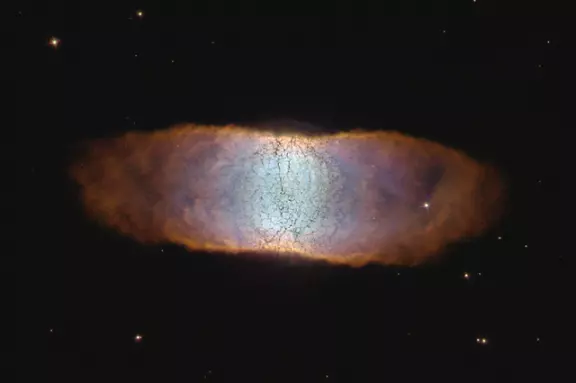
Retina Nebula (IC 4406), image: Judy Schmidt (CC BY 2.0)
SN 1006
SN 1006 is a historic supernova, seen between April 30 and May 1 of the year 1006 in the constellation Lupus by observers across the world. It occurred at a distance of 7,200 light years from Earth and it was the brightest stellar event ever documented. It is believed to have been a Type Ia supernova and it reached a visual magnitude of -7.5.
Egyptian astronomer Ali ibn Ridwan described it as a “large circular body, 2 ½ to 3 times as large as Venus. The sky was shining because of its light. The intensity of its light was a little more than a quarter that of Moon light.”
The supernova remnant was identified in 1965 as the previously known radio source PKS 1459-41, located near the star Beta Lupi. No companions of the progenitor star were found, which suggests that the supernova had a double degenerate progenitor and was a result of the merging of two white dwarf stars.
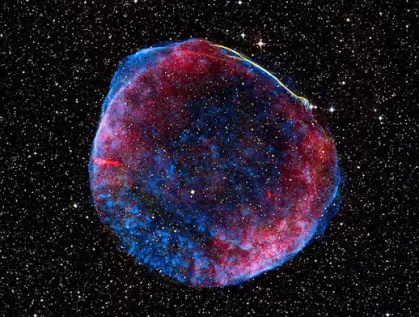
This image is a composite of visible (or optical), radio, and X-ray data of the full shell of the supernova remnant from SN 1006. The radio data show much of the extent that the X-ray image shows. In contrast, only a small linear filament in the northwest corner of the shell is visible in the optical data. The object has an angular size of roughly 30 arcminutes (0.5 degree, or about the size of the full moon), and a physical size of 60 light-years (18 parsecs) based on its distance of nearly 7,000 light-years. The small green box along the bright filament at the top of the image corresponds to the dimensions of the Hubble release image.
NGC 5822
NGC 5822 is a large open cluster approximately 6,000 light years from Earth. It has an apparent magnitude of 10.28. It is located 3 degrees to the southwest of the star Zeta Lupi.
NGC 5824
NGC 5824 is another globular cluster in Lupus. It has an apparent magnitude of 9.09 and is 104,400 light years distant from the solar system.
The cluster is located near the western border with Centaurus constellation. It can be seen in a small telescope, but its stellar core can only be resolved with a larger aperture.
NGC 5749
NGC 5749 is another open cluster in Lupus. It is about 8 arc minutes in diameter and has an apparent magnitude of 11.23. The cluster was discovered by James Dunlop in 1826.
NGC 5882
NGC 5882 is another planetary nebula in Lupus. It has an apparent magnitude of 9.4.
NGC 5927
NGC 5927 is a globular cluster in Lupus, located near the border with the constellation Norma. It has an apparent magnitude of 8.01 and is approximately 24,800 light years distant from Earth. The cluster was discovered by James Dunlop in 1826.